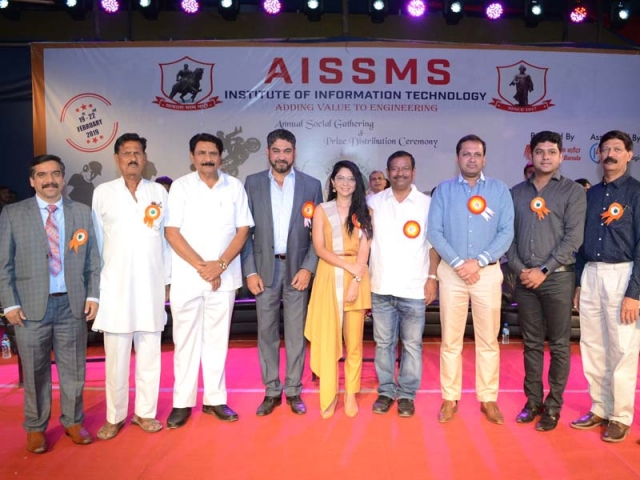Dr. Nidhi Sharma
Assistant Professor (Chemistry)
AISSMS Institute of Information Technology
Adding Values to Engineering
Monosodium glutamate (“MSG”) has become one of the most well-known and controversial food ingredients in recent history. Linked to the “Chinese Restaurant Syndrome,” the use of MSG has caused an outpouring of anecdotal evidence alleging adverse effects caused by ingestion of the food ingredient. These claims have been fueled by the popular press which has devoted considerable coverage to the debate surrounding the food additive. Yet, scientific studies have repeatedly indicated that MSG is safe at ordinary levels of consumption for the general population. In response to the controversy, in 1995, the Food and Drug Administration commissioned the FASEB Report to provide a comprehensive review of the monosodium glutamate scientific literature. This paper will examine the history of the MSG debate, including the scientific evidence, the role of the media, the positions of both sides and the response of the FDA.
“Why doesn’t everyone in China have a headache?” Jeffrey Steingarten, a Harvard Law School graduate turned renowned food critic, poses this question in an essay investigating the controversy surrounding monosodium glutamate.
A simple Internet search reflects the extraordinary degree to which the MSG question has taken hold in the United States, with numerous advocates and opponents on both sides. MSG is the quintessential “hot topic,” with those speaking out on the issue including not
only everyday consumers, but scientists, physicians and government officials. From the “NO MSG” signs plastered all over Asian restaurants to the constantly-referenced and peculiarly-titled “Chinese Restaurant Syndrome,” the American public has been made exceptionally aware of this particular flavor enhancer that has been used extensively for almost a century.
Glutamate: It’s Role in Food and in the Body
Monosodium glutamate belongs to the larger group of chemicals that are labeled “glutamate.” Glutamate is one of many different amino acids, which are considered to be the building blocks of proteins. Glutamate itself is regarded as one of the most important components in proteins. In fact, it is found naturally in many protein-containing foods, including cheese, milk, meat, fish and a number of different vegetables. The levels of MSG are particularly high in foods like tomatoes, mushrooms and Parmesan cheese. Glutamate is a key component in determining the flavor of these foods, however it only functions as an enhancer when it is in its “free” form, not when it is bound with other amino acids in proteins.
In 1908, A Professor from the University of Tokyo in Japan ‘Kikunae Ikeda’ isolated ‘monosodium glutamate’ or in short ‘MSG’ from broth of seaweed ‘kombu’ by
aqueous extraction and crystallization, that looked similar to table salt or sugar, which is having ideal storage properties. He found it as the sodium salts of glutamic acid having a long lasting taste with mouthwatering and sensation over tongue. He further described when the protein containing glutamic acid is broke down by cooking, fermentation or ripening, it becomes glutamate. He propounded the taste different from sweet, sour, bitter and salty and named this distinctive fifth taste as ‘umami’ – which translates as ‘savoury’ or “delicious taste” in Japanese – and is associated with a “meaty” flavor. He patented ‘MSG’ as a taste substance for seasoning in food. Researchers revealed MSG is the most common non-essential amino acid (means that our bodies produce it, even if we do not get it from the food we eat) and that can be easily metabolized by human body.
MSG is a major constituent of protein-rich food products e.g. meat, poultry, fish, mushrooms, seaweed, tomatoes, potatoes, nuts, legumes, and in most of the dairy products. It is found mostly in the bound state and the fraction in a free form enhances the flavor of foods. Researchers further identified and confirmed the presence of receptors on human tongue that exclusively activates by glutamate. Many fermented or ripe foods are rich in natural MSG, such as ripe tomatoes (250-300 mg/100g), parmesan cheese (1600 mg/1000g), Roquefort cheese (1600 mg/100g) and Gouda cheese (580 mg/100g). The glutamate content in milk/milk products, poultry products, meat, fish, and vegetables differ in their bound and free form. (Table1)
| Food | Bound glutamete | Free glutamate |
|---|---|---|
| milk/milk products | ||
| cow milk | 819 | 2 |
| human milk | 229 | 22 |
| parmesan cheese | 9847 | 1200 |
| Food | Bound glutamate | Free glutamate |
|---|---|---|
| poultry products | ||
| eggs | 1589 | 23 |
| chicken | 3309 | 44 |
| ducks | 3636 | 69 |
| meat | ||
| beef | 2846 | 33 |
| pork | 2325 | 23 |
| fish | ||
| god | 2101 | 9 |
| mackerel | 2382 | 36 |
| salmon | 2216 | 20 |
| vegetables | ||
| peas | 5583 | 200 |
| corn | 1765 | 130 |
| beets | 256 | 30 |
| carrots | 218 | 33 |
| onions | 208 | 18 |
| spinach | 289 | 39 |
| tomatoes | 238 | 140 |
| green peppers | 120 | 32 |
Human taste-buds are primed to distinguish between at least four basic tastes: salty, sour, bitter, and sweet. It’s long been suspected that we also have taste receptors specifically designed to detect one more basic taste “umami”. Food Additive Monosodium Glutamate “MSG” is called by its trade name “ajinomoto”. The literal translation of ‘Aji no Moto‘ is ‘Essence of Taste’. Sweet and Umami flavors are innately appetizing, whereas Sour and Bitter ones are instinctively unappetizing. Saltiness is enticing up to a certain amount, and beyond that it becomes repulsive
Researchers revealed, MSG is simply comprised of water, sodium and glutamate and is the most common non-essential amino acid that can be easily metabolized by human body. Glutamic acid is one of the two amino acids (the other being aspartic acid) or its ionic forms ‘Glutamate ‘and ‘Glutamine’ are under-rated as “good” dietary amino acids found in most high protein foods. Human body itself generates free glutamate for use as a component of metabolization or as a component of many proteins and peptides of most tissues serving as the building blocks of life.
The substances, which constitute the umami taste, can be divided in two main groups: one is the amino acid group, represented by monosodium glutamate and the other is 5′-nucleotide group, represented by inosine 5′- monophosphate (IMP) and guanosine monophosphate (GMP) and their derivatives.
- MSG has no texture or smell of its own, and therefore it serves to emphasize the natural flavor of food itself, rather than adding an independent flavor.
- By adding MSG in food appropriately, sodium chloride addition could be reduced by 30-40% while maintaining the same perception of saltiness.
- Glutamate only functions as an enhancer of taste when it is in free form and not when it is bound with other amino acids.
- MSG is not palatable to sensitive individuals.
USES OF MSG
MSG is majorly used in food applications and in food processing industries e.g. convenience foods, snacks, soups, instant noodles, condiments, and seasoning blends in permissible limits. A negligible amount of MSG is used in animal feeds. MSG is containing 78% of glutamic acid, 22% of sodium and water. By adding MSG in food appropriately, the sodium chloride addition could be reduced by 30- 40% while maintaining the same perception of saltiness. Production of the chelating agent glutamic acid N,N-diacetic acid tetra-sodium salt (GLDA) is a new and promising end use for MSG but accounts for a very small share of global consumption. Glutamate is sometimes added to food to reduce cooking and meal preparation time to provide more flavors.
MSG BENEFITS
MSG contains only 30% of the amount of sodium in table salt, and gives the same flavor enhancement in food. Food naturally high in glutamate or the inclusion of MSG in food increases taste of the food and therefore, improves the amount of intake and improves desire for the food. Glutamate is the primary source of energy for the intestine and dietary glutamate is instantly utilized by the intestine. Dietary glutamate derived from foods and fromMSG, plays important role in the digestive system, serving as a primary source of energy for the intestine.
- Free glutamate triggers the digestive process for proteins as soon as umami taste is recognized by the brain.
- A study revealed glutamate as an intestinal oxidative fuel, key neurotransmitter, and may be a useful dietary supplement to augment health of the infant gut and therefore, it may play a functional role in promoting gastric emptying and digestion.
- Another study informed about alpha-ketoglutarate (AKG), which is formed during the metabolism of the amino acid glutamate is also useful as a dietary supplement to provide a specific energy source for the developing gut in infants.
- A study showed a positive role of MSG in the improvement in haemoglobin level to those who were anemic at baseline.
It is necessary to carry out further studies before drawing such conclusions.
A study reported about the development of a readily biodegradable chelating agent called tetra-sodium L-glutamic acid, N, N di-acetic acid (GLDA) from flavor enhancer MSG in an essentially waste free synthesis, which will replace phosphates in automatic dish washing detergents that is highly soluble than conventionally used EDTA and will be offered in higher concentrations; reducing the packaging and transportation cost.
MSG CONTROVERSIES
A hypothetical MSG symptom complex, named “Chinese Restaurant Syndrome”, attracted attention in the period after 1968, when Robert Ho Man Kwok, an American Doctor reported in an article in the New England Journal of Medicine about the symptoms he felt after an American Chinese Meal . Kwok suggested possible reasons for his symptoms, including alcohol (from cooking with wine), sodium, and MSG. Many other reports targeted MSG, for it could produce Kwok’s symptoms such as numbness, weakness, flushing, sweating, dizziness and headaches. In addition to Kwok’s symptoms, many more studies reported other health issues probably caused due to a heavy or prolonged intake of MSG viz. overweight or obesity, hypertension with sleep disordered, breathing problems, neurological disorders, kidneys disorders, allergic reactions, causing cancer, and killing of dogs.
FINDINGS OVER CONTROVERSIAL ASPECTS OF MSG
Reported Chinese Restaurant Syndrome and other supporting adverse event reports triggered the US Food and Drug Administration (FDA) to ask an independent scientific group Federation of American Societies for Experimental Biology (FASEB) to conduct a study in 1990’s. The 1995 report compiled by FASEB on behalf of FDA stated that MSG is generally recognized as safe (GRAS). FDA says that MSG occurs naturally in many foods and people around the world have eaten glutamate-rich food throughout the history. Outcome of the study concluded no evidence for MSG food intake and serious or long term medical problems.
A study at Virginia to check CRS symptoms, in particular, flushing of skin after feeding 24 subjects with 3 gram and 5 gram doses of MSG found no MSG-provoked flushing.
One of the largest studies in 1998 using doubleblindplacebo-control testing, which was done with 130 subjects who declared to have MSG intolerance found no adverse reaction with MSG or placebo when taken with food. In a double-blind crossover study done by two Italian scientists examining 17 males and 7 females, between the ages of 18 and 34 administering 3 gram doses of MSG reported a number of CRS symptoms, including headache, flushing and tightness in the chest, whereas the group that received the actual MSG broth reported no such symptoms. The joint AO/WHO Expert Committee report on Food Additives (JECFA) reported that the controlled double-blind crossover trials have failed to demonstrate the relationship between Chinese Restaurant Syndrome ‘CRS’ and MSG intake. Many studies reported for any reactions that were observed with intake of MSG were mild, transient and not life-threatening and many other studies did not support CRS symptoms with or without MSG in food. A few studies revealed for healthy MSG intolerant people, the MSG symptom complex tends to occur within one hour after eating 3 grams or more of MSG on an empty stomach or without other food. Allergic reactions, generally takes place due to a food containing protein. MSG is a sodium salt form of a glutamic acid or glutamate that can be found in protein, but with no link to any other molecule for being in the free form. Some people are allergen to certain food intake whether with or without containing MSG. According to the American College of Allergy, Asthma and Immunology, MSG is not an allergen.
A study on hypertension linked to suspected MSG intake reported a positive link. Another study argued with MSG contains only 30% of the amount of sodium, which is clinically proven to be a related cause of high blood pressure and is largely found in table salt. Switching over to MSG at far lower levels gives the same flavor enhancement in food. A study stated that “when certain amino acids are heated to 350-5000C or 660-9000F, certain cancer causing compounds could be formed”. A study argued those findings, as the dietary intake of glutamate does not require temperature to this extreme and the normal cooking temperatures are generally below 2500C
CONCLUSION
MSG has been used for more than 100 years to season food or to enhance flavor of the food. Undesirable health symptoms reported by some investigations on different aspects in consuming MSG at various levels has always been an issue of concern. Most people can consume dietary glutamate in large amounts or their body can metabolize glutamate efficiently. There have been no known or scientifically proven studies that link adverse reaction among human-beings to MSG except to those, sensitive or allergic to some part of the food or to people, those are pre-existing to vitamin B6 deficiency and also a large amount of MSG intake may cause certain health issues. A review data from the World’s top scientific sources reveals that MSG is safe for human consumption and so as the international and national bodies governing food additives. Under the Indian food laws, MSG is a permitted additive in foods with labels to indicate its presence. Use of MSG in the food processing industries is a sector with promising leaps and bounce for growth in times to come. Many studies revealed important benefits of glutamate to human health, beyond its role as a food component. MSG can provide significant nutritional benefits to elderly people to whom losses in taste and smell restrict desire for food intake. More studies are needed on humans to combat any adverse link of MSG intake on over weight/obesity, cancer, and on kidney functions. In contrary to neutralized or newly emerged ifs & buts on MSG consumption; its demand is increasing worldwide with a huge money exchange. Top of Form
















